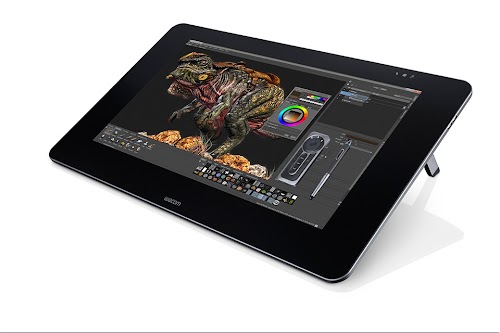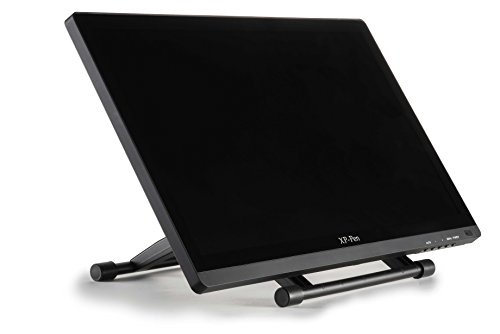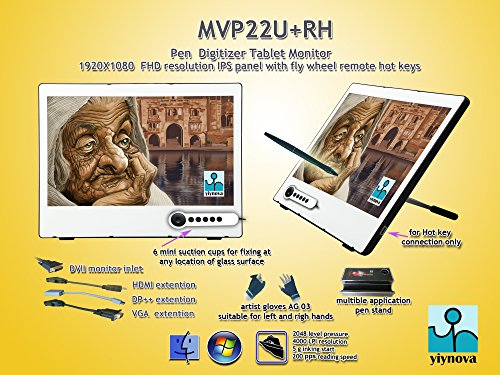Roundup of Pen Display Monitors for Graphic Artists & Designers
Two years has passed since I compiled the list of pen displays in 2015.
Here's the updated list of all the pen displays/monitors and Cintiq alternatives as of January 2017. If you want detailed reviews for specific models, check out the reviews I've published so far. This list below is a just guide that looks at the pros and cons of available options currently in the market.
This list does not include portable tables such as iPad or the Surface Pro 4. If you're looking for a portable setup, visit this article.
Why choose a pen display/monitor over portable tablets for drawing
One advantage that pen displays offer over portable tablets is the screen size. For the same price, you can get a pen display with a larger screen. A larger screen is more comfortable to draw on and easier on your eyes. It's like drawing on an A4 vs A5 paper. With a smaller screen, user interface may be small and you have to squint your eyes to see.
The other advantage is pen display technology has matured and offers better accuracy and sensitivity compared to tablets and their stylus. The only tablet and stylus combination currently that can match pen displays or tablets like the Wacom Intuos is, in my opinion, the iPad Pro and Pencil, but even that is a compromise because it's running a tablet OS, which brings me to the next point.
Pen displays allow you to use your existing computer, OS and desktop software. Note that there are tablets that run Windows 10 and can use desktop software, however because of the screen size, sometimes they are not the best choice to run those software, e.g. small user interface, or interface not design for small screen form factor. Moreover, such tablets are often not as accurate compared to pen displays.
So basically, if you're looking for large screen, accuracy and the ability to use desktop software, going with pen displays is the more appropriate choice.
Alright, the list of pen displays or Cintiq alternatives are arrange alphabetically according to brand.
Artisul

Artisul is a brand from UC-Logic, a company based in Taiwan. It is known for having its pen digitizer technology used in other pen displays, so much so that sometimes you can install its driver to use with other brands.
In recent years, they have released their own products, and they are the Artisul D10 (2016) and Artisul D13 (2016). I've personally reviewed both and I'm pleasantly surprised by how well they perform.
+ Good build quality
+ Tactile buttons with good feedback
+ Can be powered by USB 3 port
+ Stand can be used for other tablets
+ Stand can be adjusted to many positions
+ Cheaper than Cintiq 13HD
+ Runs cool, only the bottom right is slightly warm
+ Wireless and battery-less pen
+ Pressure sensitivity works great
+ Strokes taper well* and have no jitter
+ Relatively lightweight, compact, and hence portable.
- Parallax exists, corrected by calibration
- Windows drivers can't customize specific keys or combos
- Only HDMI port so you might need an adaptor
- Strange stroke tapering effect in Photoshop (Windows)
If you have limited budget, Artisul D10 and D13 are good pen displays to consider. The added advantage is since they are small, you can easily bring them around if you need to.
Bosto

Bosto is a company from China. These are the current pen displays they sell currently, arranged from large to small:
In short, the mini versions are the pen displays without the physical shortcut buttons. They are all IPS panels with 1080P resolution. Drawing functionality and performance is competitive to other brands. I've reviewed the 22HDX before and it works well on Windows with some issues to the physical shortcut buttons. On the Mac it wasn't that good. Hopefully, they will come up with new models in the future and better drivers for the Mac.
Dell
Dell isn't a company that I would expect to go into the pen display market for creative professionals but in CES 2017, the Dell Canvas was announced.
Every since I saw the Microsoft Surface Studio, I had wished for that monitor to be sold separately. Dell Canvas is that monitor, except at a lower resolution.
This is a 27-inch pen display features a 2560 x 1440 resolution, and it supports 100% Adobe RGB. It also comes with a remote called the Totem that looks quite similar to Microsoft Surface Studio's Dial.
The best part is, the Dell Canvas is said to be using Wacom technology. The battery-less pen will support 2048 levels of pressure sensitivity and tilt.
The estimated shipping date is in April 2017.
Huion
Huion is probably the arch nemesis of Wacom. They probably have released more tablets and monitors than Wacom has in the recent years, and they are getting better each year.
This is the company that really pushes the Wacom the market leader and I like that because with competition you get better products. And in Huion's case they want to create products as good but sell at a cheaper price.
The pen displays that Huion is currently selling are:
Huion pen displays have decent build quality. They support features like 2048 levels of sensitivity, IPS panels with good colour reproduction, extra replaceable nibs for the pen.
For some reason, the Huion pen displays work almost flawlessly on Macs. On Windows, more specifically with Photoshop, there's this slight jittery effect to the strokes, at least for the GT-220 ver 1 that I tested. It could be a non-issue if you're getting it for photo editing, but for drawing I prefer the strokes to come out perfect. Luckily there's this plugin called Lazy Nezumi Pro (not free) that smooths out the Photoshop strokes.

Huion has since released GT-220 ver 2 and that has been getting mostly positive reviews.

If you prefer a smaller form factor, there's the new Kamvas GT-156HD. Despite the smaller screen, the price is surprisingly similar to the big brother GT-220. The specifications of the smaller Kamvas is pretty similar to other Huion pen display, except it has physical buttons.
It features a 1080P screen with 14 express keys and touch bar, anti-glare screen, new driver and pen.
Microsoft

Microsoft Surface Studio is on this list because you can also use desktop software with it.
The 4500 x 3000 resolution screen is a beauty, and with the hinge system you can move it into any angle. It's a 28-inch 4500 x 3000 resolution screen. There's no mention of the exact gamut range it supports except that it supports a "wide color-gamut". Microsoft promises fast color profile switching between sRGB, DCI-P3, and Vivid (P3-D65).
The price insane, with the base model starting at USD $2,999.
My only concern is the accuracy and sensitivity of the Surface Pen. All other pen displays on this page feature excellent accuracy (after calibration) and sensitivity. I've used Surface 3 and Surface Pro 4 and they suffer from the common tablet-stylus problem of jittery strokes when diagonal lines are drawn slowly. Unfortunately, I've read online that this issue is still present even in the Surface Studio.
Monoprice

I always feel that Monoprice is a rebranded pen display. Their pen displays are similar in physical design to Huion, Ugee and Bosto mini. So it can be the case of identical pen displays coming from the same factory but branded differently.
There's the Monoprice 22 (2016) which looks like the Huion GT-220 and the Monoprice 19 (2014) which looks like the Huion GT-190.
Not just design, the specifications are also very similar. 2048 levels of pressure sensitivity, 1440x900 resolution, TFT panel with 16.7 million colours, 250cdm2 brightness, 700:1 contrast ratio.
So I really can't say who copied who. Huion, Monoprice, Ugee or Bosto?
Parblo
I've not heard of Parblo until a reader told me about it.

This company has two pen displays, the Parblo Coast10 (2016) and the Parblo Coast22 (2016).
Specifications are quite similar to other Cintiq alternatives so it's difficult for them to stand out. Their pens are battery-less. The Coast10 even has a build-in pen holder above the screen which is something I don't see in other brands, so I guess this is probably not one of those rebranded tablets.
Ugee

Ugee only has two pen displays, the 2150 (2015) and HK1560 (2016). Reviews for them are quite good on Amazon.
Here are the respective detailed reviews for both models:
https://www.parkablogs.com/picture/review-ugee-ug-2150-pen-display-moni…
https://www.parkablogs.com/picture/review-ugee-hk1560-pen-digitizer-dis…
The Ugee 2150 is very similar to the Huion GT-220. So the pros and cons are pretty similar.
Wacom

Wacom currently has lots of different Cintiq available but for simplicity's sake, I would just group them into two: the old and the new.
The older generation Cintiqs are the 13HD (2013), 22HD (2012), 24HD (2011), 27QHD (2015).
They are the only company with pen displays that also feature finger gestures (at an additional price compared to standard models). Build quality is excellent. Their drivers work with almost all software and generally have no issues (of course there are exceptions). The main advantage is they play well with all the Adobe software. And because a lot of artists use Wacom, whenever there are issues, you can usually find the same problem on forums, and maybe with an accompanying solution.
The Cintiqs from Wacom are quality products that command the additional price premium.

Those are the older models. Going forward in 2017, Wacom has released the Cintiq Pros.
There's a 13.3-inch model which features 1080P resolution, and the 15.6-inch model with the 3840 by 2160 (4K) resolution. The 15.6-inch model is the first pen display (not tablet) that I know of to have such a resolution. And such high resolution means you must work with recent software that have been updated to take advantage of that resolution. If you're using older Adobe software (CS6 and older), you're going to see tiny user interface.
The new Wacom Pen 2 features 8192 levels of pressure sensitivity and 60 degrees of tilt sensitivity (which currently is a feature only Wacom has currently). There are no physical shortcut buttons and are instead replaced by the Wacom ExpressKey which is extremely handy and sold separately.
If you want the best pen display and have the budget for it, then the Wacom Cintiq Pro is currently the best there is. Hopefully, they will come up with even larger sizes. 4K on a 15.6-inch screen just doesn't cut it for me. I like larger screens!
Wacom pens do not require batteries, just like the pens from Artisul, Bosto, Parblo and the one from Dell Canvas.
Wacom Cintiq Pros color gamut support is at 87% and 94% Adobe RGB respectively.
XP-PEN

The physical design of the XP-PEN 22HD (2016) also looks similar to the Huion, Ugee, Bosto Mini and Monoprice.
I was sent one for review and I was pleasantly surprised by how well it worked. It actually had none of the Photoshop strokes issues that I've experienced with Huion. It works well with all the graphics app that I've tested on both Windows and Mac. Usually when I review such pen displays, there would usually be some issues with some apps but for the most of the apps except Mischief, the XP-PEN 22HD works almost flawlessly. Having a good driver really makes all the difference in functionality.
Usual specs are there. 1080P, IPS panel, 2048 levels of pressure.
Pros
+ Good built quality
+ IPS panel with good colour reproduction and viewing angles
+ 2 pens include
+ Spare nibs included
+ 2048 levels of pressure sensitivity works well
+ Input for DVI and HDMI, and has adaptor for mini-DisplayPort to HDMI
+ Works well with most Windows and Mac graphics app, except Mischief (Windows)
Cons
- Glossy screen prone to reflections, depends on your working environment
- No shortcut buttons on the monitor itself
- Gets warm at lower right after a while
- Wires behind prevent the display for going to it's lowest possible position
- Parallax that's compensated by software settings
- Pen needs charging
Yiynova

I've many Yiynova pen displays featured on the blog, from smallest to biggest:
- Yiynova UC-logic SP-1001 Pen Digitizer Tablet Monitor
- Yiynova MVP10U Tablet Monitor
- Yiynova MVP10UHD+IPS USB Digitizer Tablet Display
- Yiynova MSP19U+ Tablet Monitor
- Yiynova MVP20U+RH
- Yiynova MVP22U V3 Pen Digitizer Tablet Monitor
- Yiynova MVP22U+RH Pen Display Monitor
Reviews for their pen displays are generally positive. However, the latest model which is the MSP19U+V5 and the MVP22U(V3)+RH are from 2015. While not as new as the competition, their performance and drawing functionality are still good enough to compete. Hopefully, they will release new products soon.
They have a pen display with remote that feels like it was inspired by the Wacom ExpressKey Remote.
Detailed reviews
To check out detailed reviews of specific pen display models I've featured on this blog, visit
https://www.parkablogs.com/content/list-of-art-products-reviewed
Conclusion
So many pen displays, which one should you get?
If you want the best, go for Wacom Cintiq Pro, perhaps the Microsoft Surface Studio or Dell Canvas.
If you want the all round budget performer with a larger screen at affordable price, check out the XP-PEN 22HD or the Huion GT-220 v2.
If you want something compact, check out the Artisul D10 and D13, Huion Kamvas GT-156HD and Wacom Cintiq Pro.
If you want budget, then it has to be the smaller Artisul D10 and D13.
If you find this compilation helpful, share it with your artist friends.
Comments
Crisp, quite lucid yet
Crisp, quite lucid yet succinct... Very well written. Thanks for doing this.
I think I like the 22ish inch ones from huion and xp-pen. I work mainly on Windows 10.
Looking at online reviews for the two I gather that both have lag with strokes..sort of.. this could be because of a slow processor or driver issue.
I am a beginner/hobbyist but eager to better my drawing skills. So what are your suggestions that I should consider for my current level and which one would suit my needs better.
I use Windows 10 on a fairly moderately powered laptop.
Thank you for your reviews.
Thank you for your reviews. Do you think a Dell totem could potentially be used with a Yiynova MVP22U+FE Full HD Tablet Monitor? Potentially as an add on?
@Brian Weerts
In reply to Thank you for your reviews. by Brian Weerts (not verified)
@Brian Weerts
From the product photos, it looks like the Dell Totem can only be used on the Dell Canvas
Your reviews are always the
Your reviews are always the best - it's so valuable to have a reviewer who understands the tech, but is an artist, and understands our needs, too.
I'm torn right now between the Huion and XP-Pen 22 inch models, with the buttons. The slider on the Huion seems valuable, but it seems implied that all 16 buttons on the XP-Pen can be mapped independently, rather than the same 8 reflected left and right like the Huion.
If someone made a plug-in that made the Huion buttons independent from each other, so you cold have another slider for brush size, opacity, or whaatever, that would be cool. (Saying that because I bet Huion reads this blog. You're that good. :) )




Add new comment